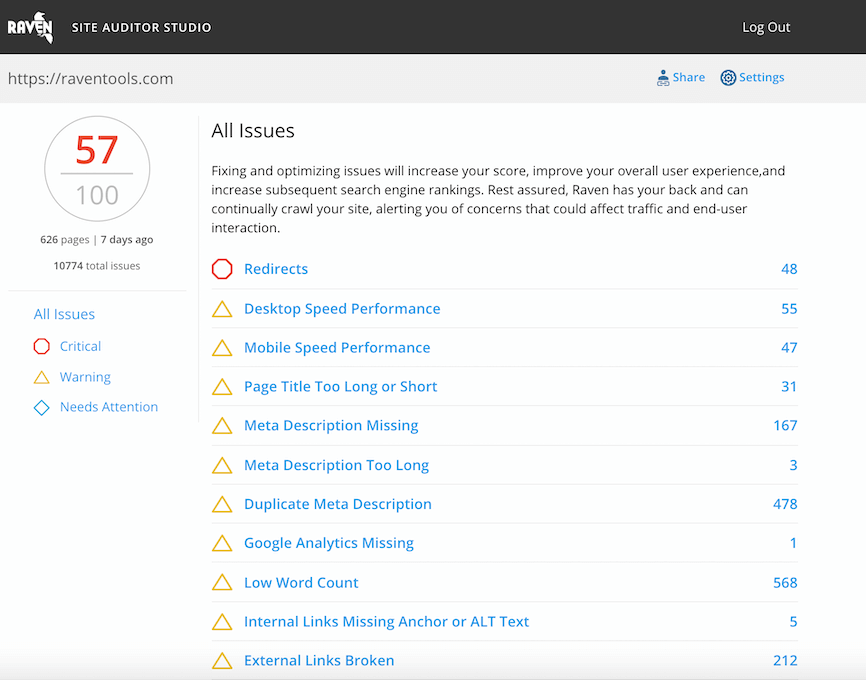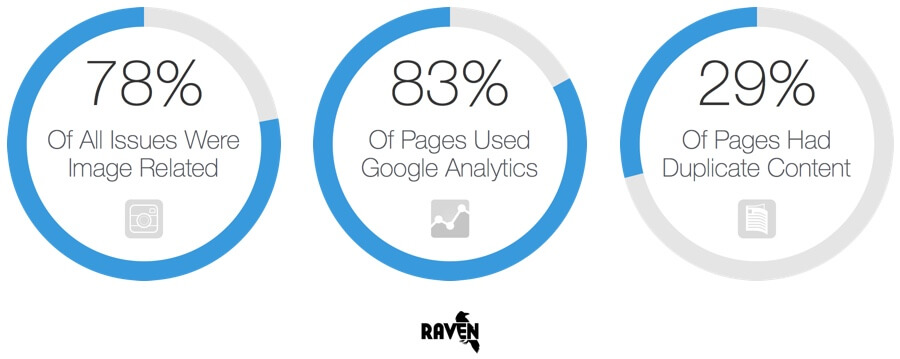The dichotomy of today’s sites is that they are easier to make, but they are also more complicated and prone to issues and errors that can affect search visibility. Even if you’re someone who has been creating websites for decades (like myself), the likelihood of making some optimization mistakes is still very high.
Since making mistakes is unavoidable, we created an automated Site Auditor to help SEOs quickly identify and fix problems. Our Site Auditor launched in 2013, and since then we have collected a lot of data – 200 million pages and over 4 billion issues. We thought it would be interesting and useful to anonymously analyze where we’re all falling short.
The results ended up being eye opening.
Key Findings
Image optimization is the most widespread on-page SEO issue today.
There were more image issues than all other types of issues combined. Learn what images lack.
Google has an analytics tracking monopoly.
83% of pages had Google Analytics installed. Cope in a Google-dominated world.
Duplicate content remains at large.
29% of pages had duplicate content. Act on this missed opportunity.
In this report, we include our key findings, along with a detailed analysis of each finding. Our hope is that we can all start focusing more on the common issues when creating sites, so they can become less common.
Update About Image Titles: 10/15/2015
A few people have dismissed the image title attribute as not having any influence on SEO. However, Google does consider both the title attribute and caption when analyzing an image. They clearly state this in their Search Console Image Publishing Guidelines:
Provide good context for your image
The page the image is on, and the content around the image (including any captions or image titles), provide search engines with important information about the subject matter of your image. For example, if you have a picture of a polar bear on a page about home-grown tomatoes, you’ll be sending a confused message to the search engines about the subject matter of polarbear.jpg.
Wherever possible, it’s a good idea to make sure that images are placed near the relevant text. In addition, we recommend providing good, descriptive titles and captions for your images.

Analyze over 20 different technical SEO issues and create to-do lists for your team while sending error reports to your client.





With so many hundreds of millions of pictures uploaded daily on social media websites. I suppose we have started treating the old image with less respect. But as with all things, you need to dot the i’s and cross the t’s. It is not exciting and creative work. But from your research we can see that it IS important
Very true, and that doesn’t even include optimizing those images. Check out the SRCSET slides in my on-page SEO presentation. There’s even more work we need to be doing 🙂 http://www.slideshare.net/raventools/essential-onpage-seo/15?src=clipshare
First of all, this is an excellent study.
Second, I am worried about the prominence of the “missing title attributes” finding for images. The reason the vast majority of sites do not put title attributes in images is because they don’t need them if they already have the ALT attribute.
All the title does is show up as a tool-tip for users. It is not vital for SEO if you have the ALT attribute. Where a title attribute is advisable is if you have it within the HREF that is wrapped around an image, but not in the image itself.
If people read your findings and start putting in the TITLE, most likely many will just duplicate the ALT, which would be bad practice.
Glad you liked the study Steve! Regarding the TITLE attribute, Google does recommend using them. Check this out: https://raventools.com/blog/on-page-seo-study/#title — but I share your same concern in regards to people implementing them incorrectly (duping the two), especially since the ALT is supposed to be a brief description and the TITLE is supposed to be an expanded description. And I’m sure we can both agree you don’t need the TITLE to rank. It’s more along the line of optimizing ALL THE THINGS! 🙂
I do agree. The more quality mark-up you have the better, and I agree Google can use titles as another method of understanding context. My point was more about how people interpret the generic “you should use title attributes for images” advice. The vast majority of titles I see on images are simply keyword-stuff phrases, often repeating ALT text. This line in Google’s explanation is key: “provide search engines with important information about the subject matter of your image”. The title should work as a tooltip to explain the content of the image, but most people use it as another excuse to describe the content of the page that is hosting the image.
Hi Jon, I’ve read that advice from Google quite a few times now, but I remain very unsure about the use of Image Title in the SEO context… if every image needs an Alt Text – presumably for commendable accessibility reasons, the same cannot be said for Titles – Google stresses the ‘Provide Good Context’ for your images – again commendable, but by no means a requirement or SEO benefit for us webmasters.
This leads me to the weighting RavenTools gives Image Titles within the auditor and your fine analysis, to say webmasters are making an SEO mistake for not using Images Titles is too strong… my thinking is even to suggest that Missing Image Titles are the most common On-Page SEO Issue is also too harsh.
I would suggest that the Auditor tool is over aggressive in it’s weighting of this issue. Our websites are hopefully not as bad as you think.
It’s certainly subjective. It’s just one of the things we check for. In fact, we give everyone the ability to exclude anything they don’t think is important in the tool’s settings, including the ability to exclude title attributes in images if they don’t think they’re important.
Oh – Now that is cool and very interesting….
Thanks Jon great and very informative article.